07/22/2025
Go Solar with Zero-Down Financing in Florida & Illinois

Breaking Down the Solar Barrier: No Money Down, All the Benefits
If you’re like most homeowners in Florida and Illinois, you’ve probably thought about going solar. The benefits are tempting: lower energy bills, increased home value, energy independence, and that warm fuzzy feeling of doing something good for the planet. But then comes the big question that stops most people in their tracks: “How much is this going to cost me upfront?”
At TCI Roofing and Solar, we’ve heard this concern thousands of times, which is why we’ve pioneered an approach that makes the answer simple: $0.
That’s right. Zero dollars down. No massive initial investment. No emptying your savings account. Just immediate savings and a clear path to energy independence.
But how is this possible? And is there a catch? Let’s break down exactly how our zero upfront cost model works and why it’s transforming the solar landscape for homeowners across Florida and Illinois.
The Zero-Down Solar Revolution: How It Actually Works
The traditional barrier to solar adoption has always been the upfront cost. Even with falling panel prices, a complete residential solar system typically costs between $15,000 and $25,000 before incentives. That’s a significant investment—one that many families simply can’t make, regardless of the long-term benefits.
Our zero-down financing model eliminates this barrier entirely.
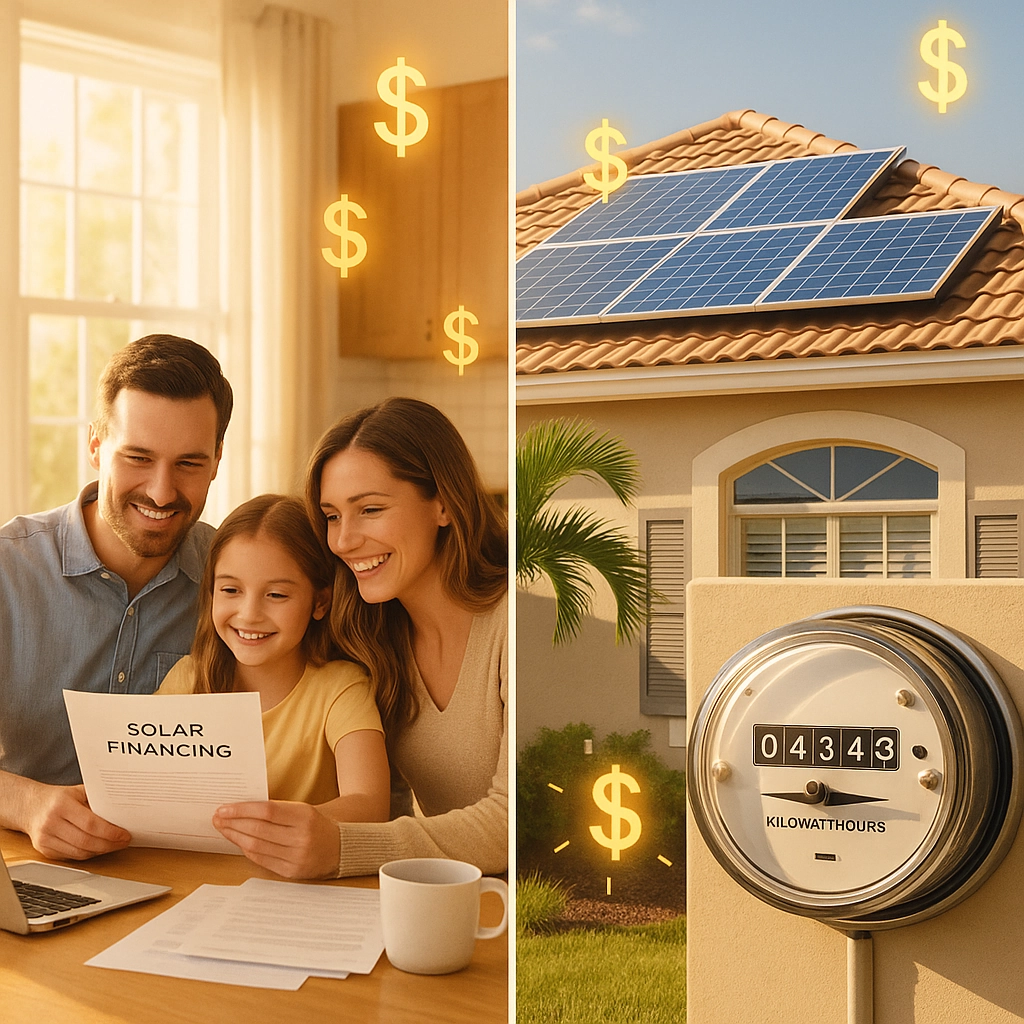
Here’s how it works:
- Qualifying is easier than you think: Homeowners with decent credit scores (typically 650+) can qualify for solar financing that requires no money down. The approval process is quick and straightforward.
- Complete system financing: The entire solar system—panels, inverters, mounting hardware, and installation—is 100% financed through specialized solar loans designed for this exact purpose.
- Lower monthly payments than your current electric bill: We structure financing so your monthly loan payment is typically lower than what you’re currently paying to your utility company. From day one, you’re cash-flow positive.
- The federal tax credit works for you: The 30% federal solar investment tax credit doesn’t disappear with financing. Instead, you receive it after your tax filing and can apply it directly to your loan principal, significantly reducing your overall cost.
As Martin Aguilar, our CEO, explains: “We’ve removed the biggest obstacle between homeowners and solar energy. When you can start saving money immediately without spending anything upfront, the decision becomes much easier.”
Florida’s Solar Sweet Spot: Maximizing Sunshine State Benefits
Florida—the Sunshine State—is practically begging for solar panels. With an average of 237 sunny days per year, Florida homeowners are perfectly positioned to capitalize on solar energy. But beyond the sunshine, Florida offers specific advantages for our zero-down solar program:
Florida-Specific Solar Advantages:
- No state property tax increase: Florida exempts the value of residential solar systems from property tax assessments. Your home value increases, but your property taxes don’t.
- Net metering policies: Florida utilities are required to credit homeowners for excess energy their solar systems produce. These credits offset your consumption during cloudy days or at night.
- Hurricane resilience: Our solar installations in Florida are engineered to withstand hurricane-force winds up to 160 mph, protecting your investment during severe weather events.
- Local incentives: Several Florida municipalities and utilities offer additional rebates and incentives on top of federal benefits.
One of our recent customers in Tampa, Florida, shared: “I was skeptical about the ‘no money down’ claim, but TCI made it happen. My electric bill went from $220 to just $16 after solar, and my monthly solar loan payment is only $180. I’m saving from month one with zero out of pocket.”
Illinois Solar: Cold Weather, Hot Savings
While Illinois might not have Florida’s reputation for sunshine, it’s actually one of the fastest-growing solar markets in the country, and for good reason. The financial benefits for Illinois homeowners can be even more substantial thanks to specific state programs.
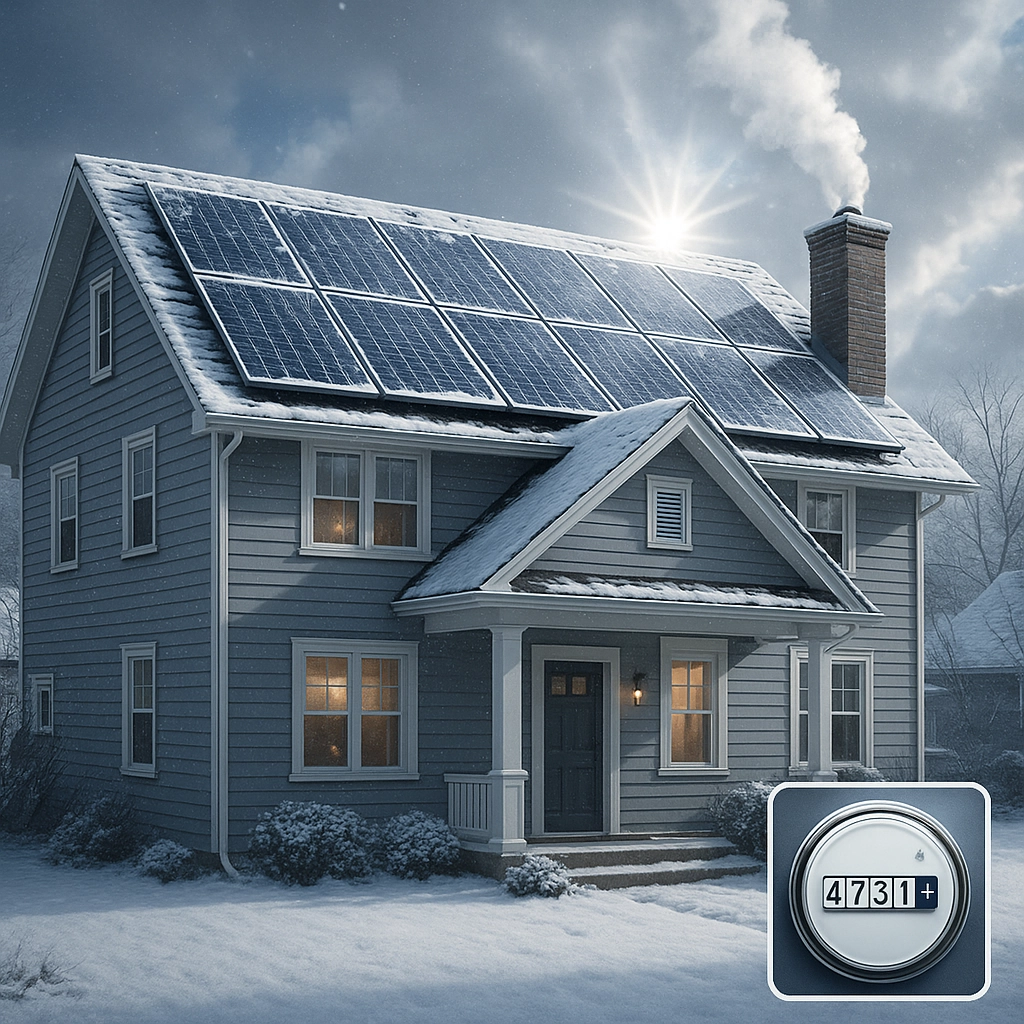
Illinois-Specific Solar Advantages:
- Solar Renewable Energy Credits (SRECs): Illinois has an aggressive SREC market where homeowners earn credits for the clean energy their systems produce. These credits can be sold for significant additional income.
- Property tax break: Like Florida, Illinois offers property tax exemptions for the added value of solar installations.
- ComEd and Ameren rebates: Illinois’s major utilities offer additional incentives and rebates for solar adoption.
- State solar incentives: Illinois offers additional financial incentives through the Illinois Shines program.
From our office in Goodfield, Illinois, we’ve helped hundreds of homeowners navigate these specific incentives to maximize their savings. Our financing program incorporates these benefits to further reduce monthly payments.
The Math Behind Lifelong Savings
Let’s get down to the dollars and cents. How exactly does zero down translate to lifelong savings?
Immediate Monthly Savings
For a typical 3-bedroom home in Florida or Illinois, we design a system that offsets approximately 100% of electricity usage. Here’s how the monthly math often looks:
- Average monthly electric bill before solar: $180-$250
- Monthly solar loan payment: $160-$200
- New monthly electric bill (connection fees): $15-$25
- Total monthly cost after solar: $175-$225
- Immediate monthly savings: $5-$25
These savings start from month one, with no money out of your pocket. But this is just the beginning.
Mid-Term Savings (Years 1-15)
As utility rates continue to rise (historically 3-4% annually), your savings grow every year:
- Year 5: ~$2,100-$3,000 cumulative savings
- Year 10: ~$5,000-$7,000 cumulative savings
- Year 15: ~$9,000-$12,000 cumulative savings
Long-Term Savings (Years 15-25+)
Here’s where the magic really happens. Most solar loans are structured for 10-15 year terms. After your loan is paid off:
- No more loan payment
- Only minimal electric connection fees remain
- Panels continue producing at 85%+ efficiency
Post-loan savings over the next 10+ years typically range from $25,000 to $40,000, depending on your energy usage and local utility rates.
Ownership vs. Leasing: Why TCI Focuses on Ownership
You might wonder why we emphasize ownership through financing rather than leasing, which also offers a “zero down” option. The answer is simple: long-term financial benefit.
Why ownership trumps leasing:
- You keep all incentives: With financing, you—not a leasing company—claim the 30% federal tax credit.
- No escalator clauses: Many solar leases include annual payment increases of 2-3%. Our fixed-rate financing keeps your payment consistent.
- Home value increase: Owned solar systems increase home values by 4-6% on average. Leased systems can complicate home sales.
- No production rights transfer: You keep all SRECs and production incentives with ownership.
- Complete after payoff: Once your loan is paid, the savings are 100% yours. Leases typically run for 20-25 years with no end to payments.
The TCI Difference: Experience Matters
With thousands of solar installations completed across Florida and Illinois, TCI Roofing and Solar brings unmatched experience to the zero-down solar equation. Our approach goes beyond just financing:
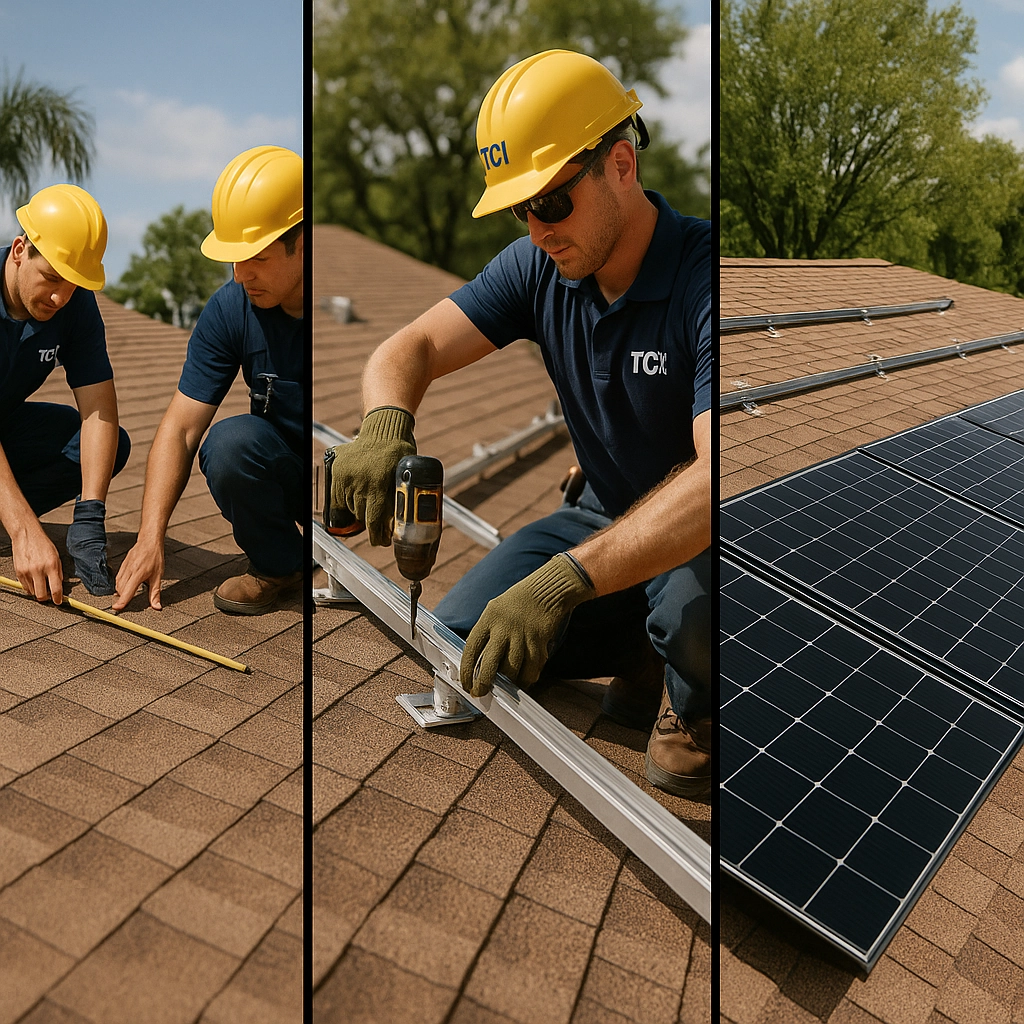
The TCI Process:
- Free, no-obligation consultation: We analyze your energy usage, roof condition, and financial goals to determine if solar makes sense for your specific situation.
- Custom system design: Our engineers design a system optimized for your home’s orientation, shading, and energy needs.
- Financing pre-qualification: We handle the paperwork to secure your zero-down financing with the best available terms.
- Professional installation: Our in-house installation teams (never subcontractors) install your system with meticulous attention to detail.
- Monitoring and support: Every system includes production monitoring and our 25-year service guarantee.
Getting Started Is Easy
Ready to explore zero-down solar for your Florida or Illinois home? The process starts with a simple, no-obligation assessment:
- Schedule a free consultation: Online at our website or call us directly.
- Share your electric bills: This helps us accurately size your system and calculate potential savings.
- Review your custom proposal: We’ll present clear financing options and projected savings specific to your home.
- Make an informed decision: No pressure, just clear information about how zero-down solar could work for you.
Beyond the Numbers: Environmental Impact
While the financial benefits of zero-down solar are compelling, there’s another aspect worth mentioning: the environmental impact. The average residential solar system offsets approximately 100,000 pounds of carbon dioxide over its lifetime—equivalent to planting about 50 trees per year.
By making solar accessible to more homeowners through zero-down financing, TCI is helping Florida and Illinois residents make a significant positive environmental impact without any financial sacrifice. In fact, they’re saving money from day one.
The Time Is Now
With the 30% federal tax credit secured through 2032, utility rates continuing to rise, and our zero-down financing options better than ever, there’s never been a better time to go solar in Florida and Illinois.
The question is no longer “Can I afford to go solar?” but rather “Can I afford not to?”
To learn more about our zero-down solar programs specifically designed for Florida and Illinois homeowners, visit our solar blog or check out how the solar tax credit can further benefit your specific situation.
At TCI Roofing and Solar, we’re making clean energy accessible to everyone—no upfront investment required, just lifelong savings and energy independence.
07/17/2025
What the End of the Solar Tax Credit Means for Florida & Illinois Homeowners
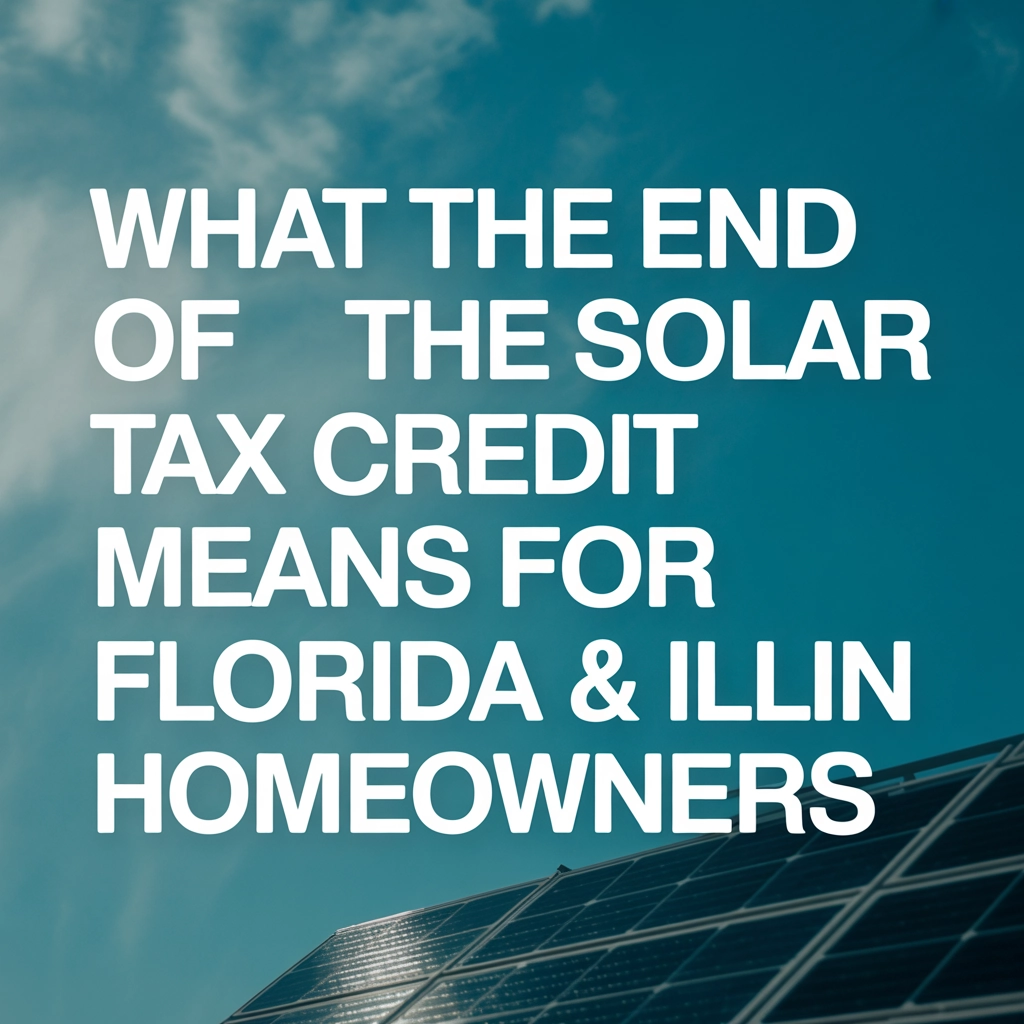
If you’ve been considering solar panels for your home, there’s a significant deadline approaching that could cost you thousands. The federal solar tax credit—officially called the Residential Clean Energy Credit—is set to expire completely after December 31, 2025. This isn’t just another tax change; it represents a potential $7,500+ difference in what you’ll pay for a typical home solar system.
For homeowners in Florida and Illinois, two states where we at TCI Roofing and Solar frequently install systems, this deadline carries particular significance. Let’s break down what you need to know and why 2025 might be your last chance to maximize your solar investment.
Understanding the Solar Tax Credit: The Basics
The federal solar tax credit has been one of the most powerful financial incentives driving residential solar adoption across America. Currently set at 30%, this credit allows homeowners to deduct nearly a third of their solar installation costs directly from their federal tax liability.
Unlike a deduction that merely reduces taxable income, this is a dollar-for-dollar credit against taxes owed. For a typical $25,000 solar system, that’s $7,500 back in your pocket—assuming you have sufficient tax liability.
But here’s the critical part: unlike previous years where we saw gradual step-downs, there is no phase-out period this time. After December 31, 2025, the residential credit drops from 30% to zero overnight.
The Financial Impact: Running the Numbers
Let’s put this in perspective with some real numbers for a typical Florida or Illinois home:
Before Tax Credit Expiration (2025):
- Average 8kW system cost: $24,000
- 30% federal tax credit: -$7,200
- Net cost after tax credit: $16,800
After Tax Credit Expiration (2026):
- Same 8kW system cost: $24,000
- Federal tax credit: $0
- Net cost: $24,000
That’s a $7,200 difference—enough to buy a decent used car or fund a home renovation project. This substantial increase affects every aspect of your solar investment:
- Payback period extends by approximately 2-3 years
- Return on investment (ROI) decreases significantly
- Monthly savings relative to installation costs drop by 30%
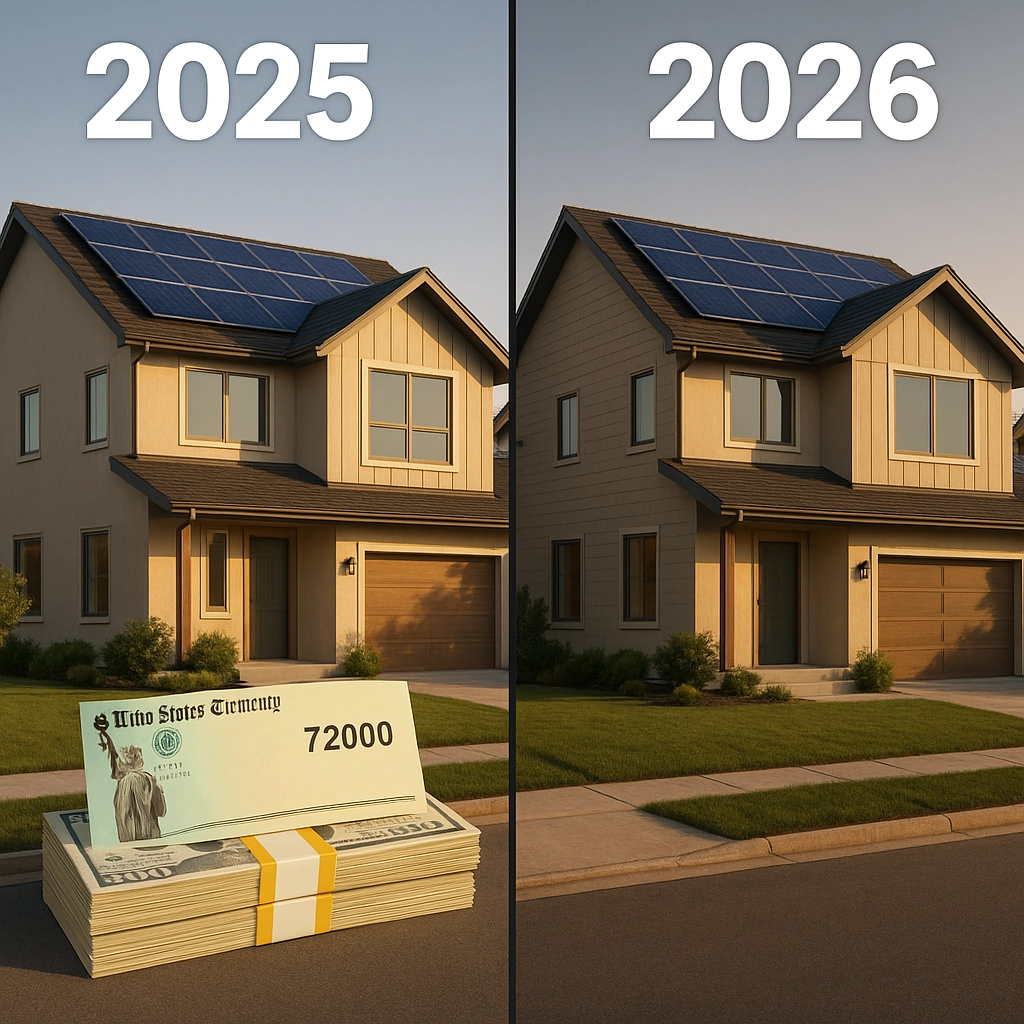
Florida Homeowners: Special Considerations
Florida’s “Sunshine State” nickname makes it ideal for solar, but the state has fewer supplemental incentives than others, making the federal tax credit especially valuable for Floridians.
What Florida Homeowners Will Still Have:
- Net metering (though policies vary by utility)
- Property tax exemption for residential solar installations
- Sales tax exemption on solar equipment purchases
What Florida Homeowners Will Lose:
- The 30% federal credit that often makes the difference between a 7-year and 10-year payback period
- The financial cushion that offsets Florida’s relatively low electricity rates in some areas
For our Pasco County and New Port Richey customers especially, we’ve observed that the federal credit often represents the tipping point that makes solar financially attractive despite modest electricity rates. Without it, the value proposition changes substantially.
Illinois Homeowners: Different State, Similar Deadline
Illinois homeowners face a slightly different scenario thanks to the state’s more robust solar incentives, but the federal deadline still looms large.
What Illinois Homeowners Will Still Have:
- Illinois Shines program (Adjustable Block Program) offering Solar Renewable Energy Credits (SRECs)
- Net metering policies that credit homeowners for excess generation
- Property tax breaks for adding solar to your home
What Illinois Homeowners Will Lose:
- The substantial 30% federal credit that works alongside state incentives
- The combined incentive package that has made Illinois one of the fastest-growing solar markets
Even with the Illinois Shines program continuing, the loss of the federal credit will still increase payback periods by approximately 2-4 years for most Illinois homeowners.
The Timeline Crunch: Why You Can’t Wait Until December 2025
Here’s where many homeowners make a critical mistake: assuming they can wait until late 2025 to start their solar project. In reality, several factors make this risky:
- Installation backlogs: As the deadline approaches, installer schedules will fill up rapidly.
- Permitting delays: Local building departments will face increased application volumes.
- Equipment shortages: Supply chain issues could resurface as demand surges.
- Weather considerations: Winter weather in Illinois and summer storm seasons in Florida can delay installations.

Most importantly, to qualify for the tax credit, your system must be “placed in service” (fully installed and operational) by December 31, 2025. Starting the process in late 2025 could easily push you past this deadline.
The Installation Timeline Reality Check
Based on our experience at TCI Roofing and Solar, here’s a realistic timeline for getting solar installed:
- Initial consultation and site assessment: 1-2 weeks
- System design and proposal finalization: 1-2 weeks
- Permitting and utility approval: 2-8 weeks (varies significantly by location)
- Equipment ordering and delivery: 2-6 weeks
- Installation: 1-3 days (typically)
- Final inspection and permission to operate: 2-4 weeks
That adds up to approximately 2-5 months from start to finish under ideal conditions. As the deadline approaches, expect these timeframes to extend significantly.
Making Solar Work After the Credit Expires
If you miss the 2025 deadline, solar can still make financial sense, but the equation changes:
Alternative Approaches After 2025:
- Focus on energy efficiency first to reduce system size requirements
- Consider solar batteries to maximize self-consumption and emergency preparedness
- Explore green financing options with lower interest rates
- Look into community solar as an alternative to rooftop installation
- Phase your installation with critical loads first if budget is constrained

The Long-Term Perspective
Even without the tax credit, solar remains a sound investment for many homeowners, especially considering:
- Rising utility rates make solar savings grow over time
- Home value increases of 4.1% on average with solar (according to Zillow research)
- Energy independence and reduced exposure to utility rate fluctuations
- Environmental benefits that many homeowners value beyond pure financials
What to Do Right Now: Action Steps
If you’re considering solar in Florida or Illinois, here’s your strategic roadmap:
- Schedule a solar consultation as soon as possible to understand your specific situation. At TCI Roofing and Solar, we provide free, no-obligation assessments.
- Get multiple quotes to compare options (though we’re confident in our value proposition).
- Check your tax liability with an accountant to ensure you can fully utilize the credit.
- Review your roof condition. Consider bundling a roof replacement with your solar installation if your roof is aging.
- Improve home efficiency with measures like blown-in insulation to reduce your overall energy needs.
- Target installation completion by mid-2025 to provide buffer time for unexpected delays.
Conclusion: The Clock Is Ticking
The end of the solar tax credit represents a significant shift in the financial equation for homeowners. While solar will continue to make sense for many after 2025, the difference in out-of-pocket costs is substantial enough that acting before the deadline could save you thousands.
For Florida homeowners battling high cooling costs and seeking hurricane resilience, and for Illinois residents facing volatile seasonal energy demands, the 2025 deadline offers a closing window of maximum incentives.
At TCI Roofing and Solar, we’re committed to helping you navigate this transition with transparent information and quality installations. Whether you’re in Florida or Illinois, we recommend starting your solar journey soon to avoid the inevitable rush as the deadline approaches.
Don’t let this significant financial incentive slip away. Contact us today to schedule your free solar assessment and take the first step toward locking in your 30% tax credit before it disappears forever.
07/16/2025 by Martin Aguilar
Solar Panel Installations in 2025: Navigating Policy Changes, Saving Money, and Going Green
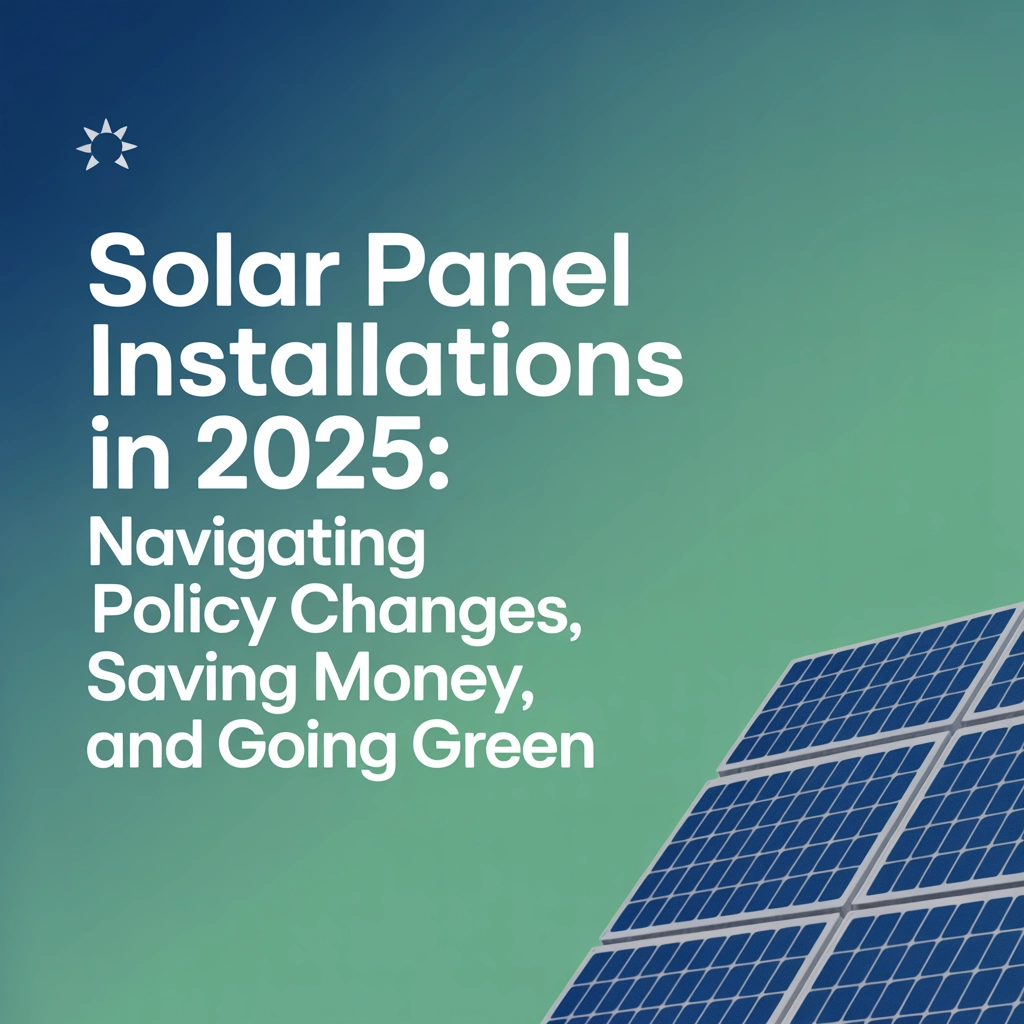
The Solar Landscape in 2025: A Critical Year for Homeowners
If you’ve been on the fence about solar energy, 2025 represents a pivotal moment. With major policy changes on the horizon, technological advancements reaching new heights, and environmental concerns becoming increasingly urgent, this year offers both opportunities and challenges for homeowners considering the switch to solar power.
At TCI Roofing and Solar, we’re seeing unprecedented interest from homeowners looking to understand what makes 2025 different from previous years. The answer lies in a perfect storm of policy deadlines, improved technology, and evolving energy markets that create a uniquely advantageous window for solar adoption.
Critical Policy Changes Affecting Solar in 2025
The solar industry has long benefited from government incentives designed to accelerate adoption, but the landscape is shifting significantly this year:
Federal Tax Credit Countdown
The most pressing change is the scheduled phase-out of the federal solar Investment Tax Credit (ITC). Currently offering a substantial 30% tax credit on the total cost of your solar installation, this incentive is set to expire completely for residential installations after December 31, 2025.
What does this mean in real dollars? For the average home solar system costing between $15,000-$25,000, the tax credit represents $4,500-$7,500 in direct savings. This single incentive has been the backbone of solar affordability for years, and its expiration will fundamentally change the financial equation for homeowners.
State-Level Incentives: A Mixed Bag
While the federal picture is clear, state-level incentives vary dramatically in 2025:
- Florida’s Net Metering Adjustments: Florida has recently modified its net metering policies, affecting how homeowners are compensated for excess energy. Current installations are grandfathered under more favorable terms, creating urgency for new installations.
- Property Tax Exemptions: Many states continue to offer property tax exemptions for solar installations, meaning your home’s value increases without corresponding tax increases—but these programs are under review in several jurisdictions.
- Utility Company Rebates: Local utilities across Florida are offering limited-time rebates to encourage grid modernization through residential solar adoption.
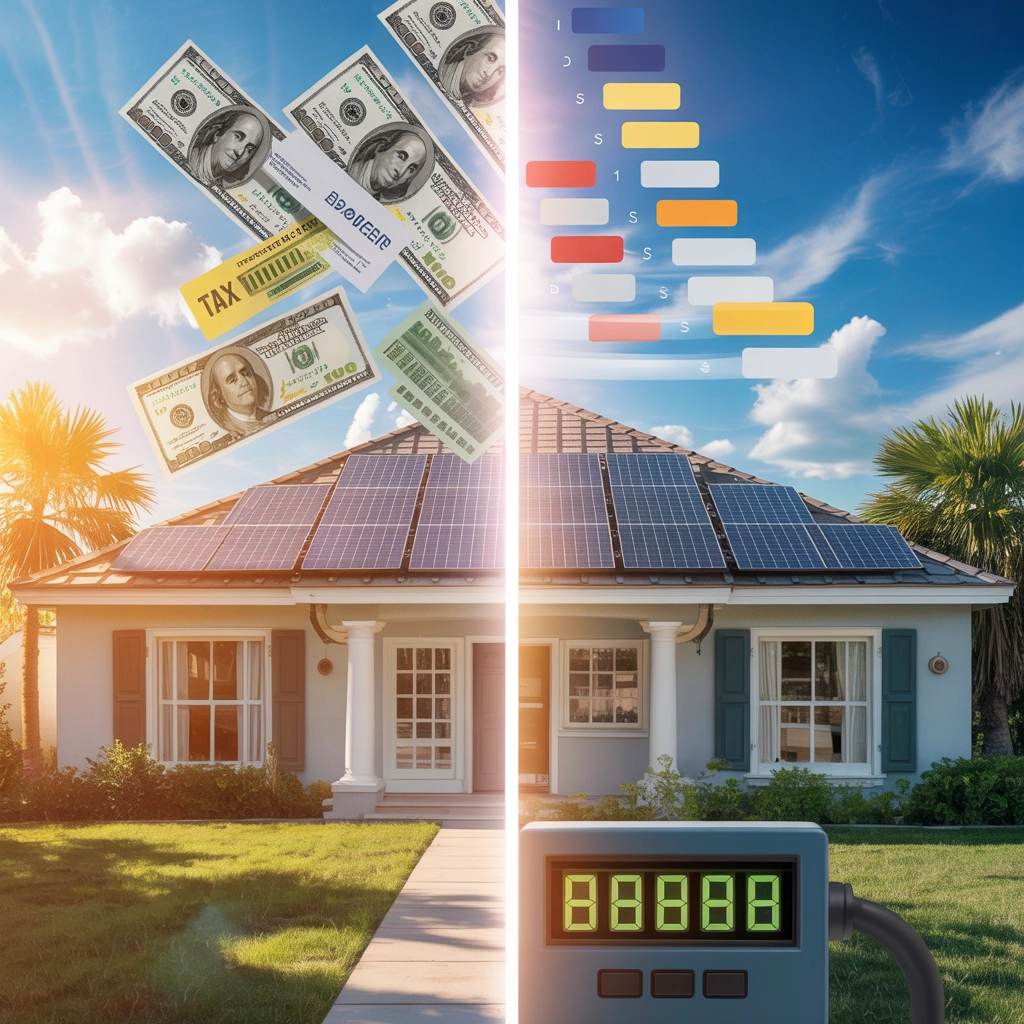
Utility Rate Structures
Another significant change in 2025 is how utilities are restructuring their rate systems:
- Time-of-Use Billing: More utilities are implementing time-of-use billing, making solar plus battery storage increasingly valuable for avoiding peak rates.
- Demand Charges: Some utilities are introducing residential demand charges, which can be effectively mitigated with strategically designed solar systems.
These policy changes collectively create a compelling case for installing solar in 2025, before the financial landscape potentially becomes less favorable.
The Dollars and Cents: Financial Benefits of Going Solar in 2025
Beyond policy incentives, the core financial value proposition of solar continues to strengthen:
Installation Costs Continue to Decline
Despite inflation in other sectors, solar hardware costs have continued their long-term decline:
- Panel prices have dropped approximately 70% over the past decade
- Inverter technology has become more affordable while offering improved functionality
- Mounting systems and balance-of-system components benefit from manufacturing scale
Our 2025 customers at TCI Roofing and Solar are seeing installation costs approximately 5-10% lower than comparable systems just two years ago, despite added functionality.
Return on Investment Calculations
The financial outlook for solar in 2025 is compelling:
- Payback Periods: Most Florida installations are reaching payback in 7-9 years
- Long-term Savings: Over a 25-year period, the average homeowner saves $20,000-$60,000 on electricity costs
- Home Value Increase: Solar homes are selling for 4.1% more than comparable non-solar properties
When factoring in rising utility rates (averaging 3-5% annual increases), the financial case becomes even stronger. Solar effectively locks in your electricity costs, providing a hedge against future rate hikes.
Financing Options Expand in 2025
The financial ecosystem around solar has matured significantly:
- Solar Loans: Specialized solar loans with rates competitive with home improvement loans
- PACE Financing: Property Assessed Clean Energy programs allow for solar costs to be paid through property tax assessments
- Solar Leases: While less common in 2025, leases remain an option for $0-down solar
The bottom line: 2025 represents a unique financial opportunity, combining the last year of the federal tax credit with historically low equipment costs and diverse financing options.
Environmental Impact: Beyond Financial Considerations
While financial benefits often drive initial interest, the environmental impact of solar remains a powerful motivator:
Carbon Footprint Reduction
A typical residential solar system in Florida offsets approximately:
- 5-7 tons of carbon dioxide annually
- Equivalent to planting 100-150 trees each year
- Or removing one car from the road
Grid Resilience and Energy Independence
Solar installations, especially those with battery backup systems, contribute to:
- Reduced strain on aging electrical infrastructure
- Decreased vulnerability to outages and price spikes
- Lower demand for new fossil fuel generation plants

Community Impact
The collective effect of increased solar adoption creates tangible community benefits:
- Improved air quality from reduced local power plant emissions
- Economic development through local installation jobs
- Decreased need for utility infrastructure upgrades (often passed to consumers)
2025’s Solar Technology: Not Your Parent’s Solar Panels
The technology available to homeowners in 2025 has evolved significantly from even a few years ago:
High-Efficiency Panels
Today’s standard panels convert 20-22% of available sunlight to electricity, compared to 14-16% just a decade ago. This increased efficiency means:
- More power from limited roof space
- Better performance in suboptimal conditions
- Improved aesthetics with sleeker, lower-profile installations
Integrated Battery Storage
Battery systems have revolutionized the solar value proposition:
- Time-shifting energy use to maximize savings under time-of-use rates
- Providing backup power during outages
- Enabling greater energy independence
- Supporting grid stability
Smart Home Integration
Modern solar installations seamlessly integrate with home automation:
- App-based monitoring and control
- Optimization algorithms that learn usage patterns
- Integration with smart thermostats and appliances
- Electric vehicle charging coordination
The technological improvements available in 2025 make this an ideal time to invest in a system that will serve your home for decades.
Practical Steps: Navigating Your Solar Journey in 2025
If you’re considering solar this year, here’s a practical roadmap:
Assessment and Timing
Given the December 31, 2025 federal tax credit deadline, working backward:
- Summer/Fall 2025: Last practical window to ensure completion before year-end
- Initial consultation: Allow 2-4 weeks for site assessment and proposal development
- Permitting: 2-8 weeks depending on local jurisdiction
- Installation: Typically 1-3 days for the physical installation
- Inspection and interconnection: 2-6 weeks for utility approval
Starting the process by mid-year provides adequate buffer for unexpected delays.
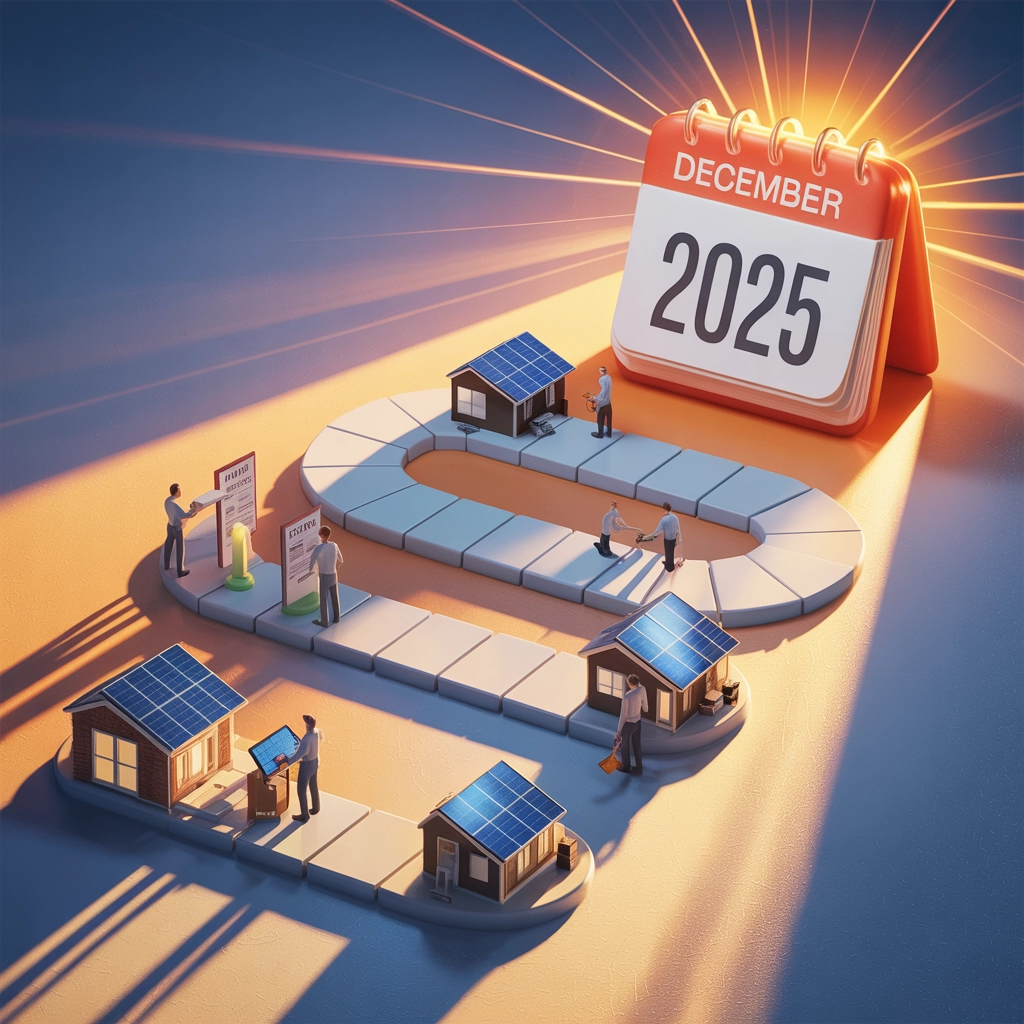
System Design Considerations
Several factors will impact your specific installation:
- Roof orientation and shading: South-facing, unshaded roofs maximize production
- Roof condition: Consider combining solar with a roof replacement if your roof is near end-of-life
- Current and future electricity needs: Account for potential additions like electric vehicles
- Battery storage: Evaluate whether backup power is important for your situation
Selecting a Qualified Installer
The installer you choose significantly impacts both short and long-term outcomes:
- Verify proper licensing and certification
- Check reviews and ask for references
- Confirm warranty coverage for both equipment and workmanship
- Understand post-installation support offerings
At TCI Roofing and Solar, we pride ourselves on maintaining the highest standards in solar installation, with transparent pricing and industry-leading warranties.
2025: A Uniquely Opportune Moment for Solar
As we’ve explored, 2025 represents a convergence of factors making it an optimal year for solar investment:
- The final year of the 30% federal tax credit
- Favorable state policies still in effect
- Historically low equipment costs
- Advanced technology with improved functionality
- Rising utility rates enhancing long-term savings
- Growing environmental urgency
For homeowners considering solar, the message is clear: while solar will continue to be a good investment in the future, the specific advantages available in 2025 create a compelling case for acting now rather than later.
Taking the Next Step
Ready to explore whether solar makes sense for your home in 2025? The team at TCI Roofing and Solar offers free, no-obligation consultations to help you understand your options. With our expertise in both roofing and solar, we provide integrated solutions that maximize both performance and protection for your home.
Contact us today to schedule your personal solar assessment and discover how the unique opportunities of 2025 can benefit your home, your wallet, and the planet.
07/15/2025
Florida’s New Roofing Laws: What Homeowners Need to Know in 2025

As a Florida homeowner, your roof isn’t just another part of your house—it’s your first line of defense against the Sunshine State’s extreme weather conditions. With hurricanes, intense heat, heavy rainfall, and high humidity, Florida roofs take a beating year after year.
To address ongoing challenges in the roofing industry and better protect homeowners, Florida has introduced several new roofing laws for 2025. These changes affect everything from insurance coverage to contractor requirements and consumer protections.
Let’s break down what these changes mean for you and how to stay ahead of the game.
The Big Picture: Florida’s Roofing Landscape in 2025
Florida’s roofing regulations have evolved significantly in response to climate challenges, insurance industry concerns, and consumer protection needs. The 2025 updates represent the most comprehensive overhaul in years, targeting longstanding issues that have affected homeowners across the state.
These new regulations aim to:
- Create more transparency between homeowners, contractors, and insurance companies
- Reduce fraudulent claims and poor workmanship
- Extend roof lifespans through better maintenance
- Protect consumers from predatory contracting practices
- Improve the overall quality and resilience of Florida’s housing infrastructure
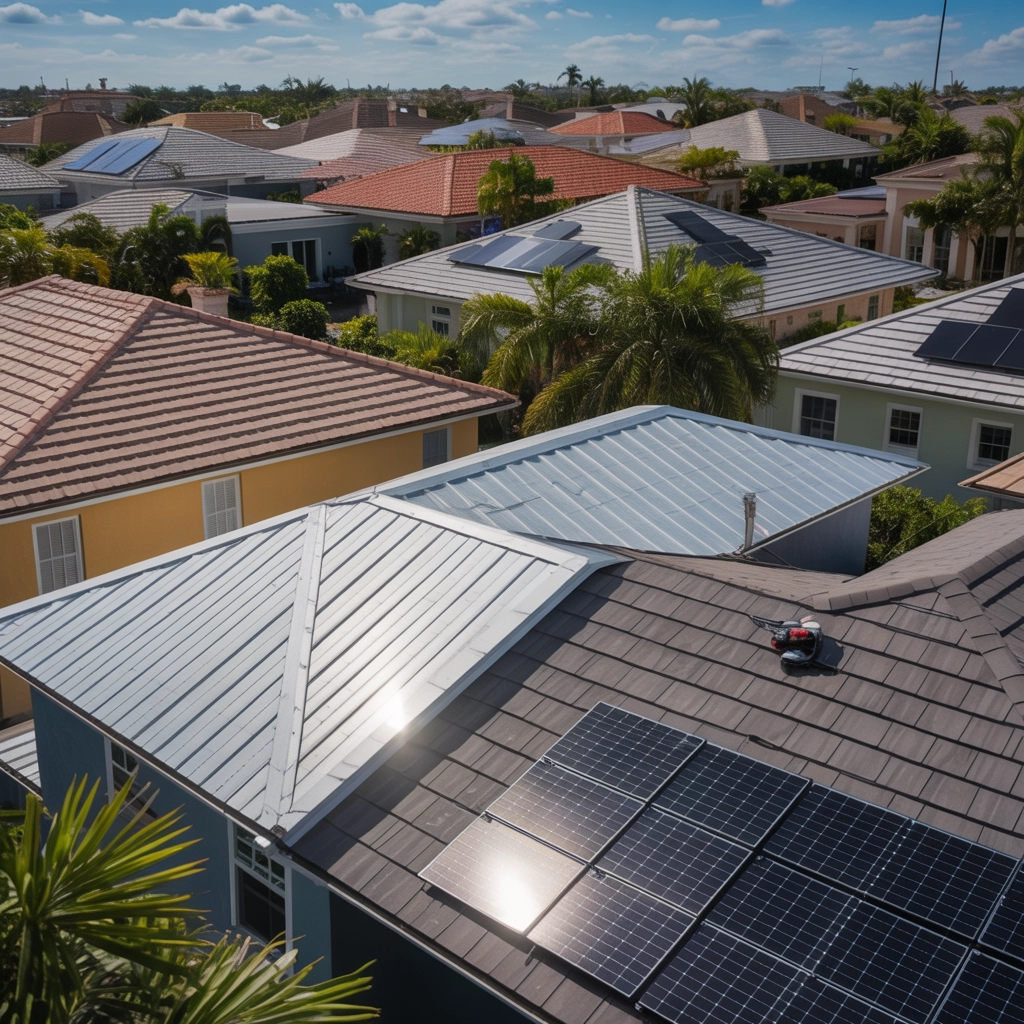
Insurance Changes: Age Matters More Than Ever
One of the most significant changes affects how insurance companies handle roof claims. Under the new laws, insurance providers have gained broader authority to deny full roof replacement claims based on roof age.
What You Need to Know:
- Age-Based Coverage: Insurance companies can now more easily deny full replacement coverage for roofs that are typically 10-15+ years old.
- Depreciation Schedule: Many policies now include a depreciation schedule for roofs, meaning older roofs receive less coverage regardless of condition.
- Maintenance Documentation: Insurance companies can require proof of regular maintenance and inspections to approve claims.
- Partial Coverage Options: Some insurers now offer “actual cash value” rather than replacement coverage for older roofs, leaving homeowners to pay the difference.
Ron Swansea, a senior claims adjuster at a major Florida insurance provider, explains: “The days of getting a complete roof replacement for minor damage are largely behind us. The new regulations allow us to assess roof age and maintenance history much more thoroughly before approving full replacements.”
What This Means for Homeowners:
Regular roof inspections and maintenance are no longer optional if you want to maintain your insurance coverage. Documentation of all roof work becomes essential for supporting future claims. Consider:
- Scheduling professional roof inspections at least once a year
- Documenting all maintenance and repairs with photos and receipts
- Addressing minor issues before they become major problems
- Understanding the specifics of your policy’s roof coverage
New Contract and Documentation Requirements
The 2025 laws have substantially increased the documentation requirements for roofing projects. These changes aim to reduce disputes and ensure homeowners are fully informed before work begins.
Required Contract Elements:
- Detailed Scope: Specific description of all work to be performed
- Materials List: Comprehensive inventory of all materials to be used
- Timeline: Clear start and end dates for the project
- Payment Schedule: Detailed breakdown of payment milestones
- Warranty Information: Specific warranty terms for both materials and labor
- Insurance Verification Notice: A statement advising homeowners to check their insurance coverage before signing
Additional Documentation Requirements:
- Proof of contractor licensing
- Proof of worker’s compensation and liability insurance
- Copies of all necessary permits
- Written warranty documentation
- Pre-work inspection reports
- Post-work completion certificates
Angelo Ponce from APC Roofing emphasizes, “The documentation requirements may seem excessive, but they actually protect both parties. Clear contracts mean fewer disputes and better outcomes for everyone involved.”
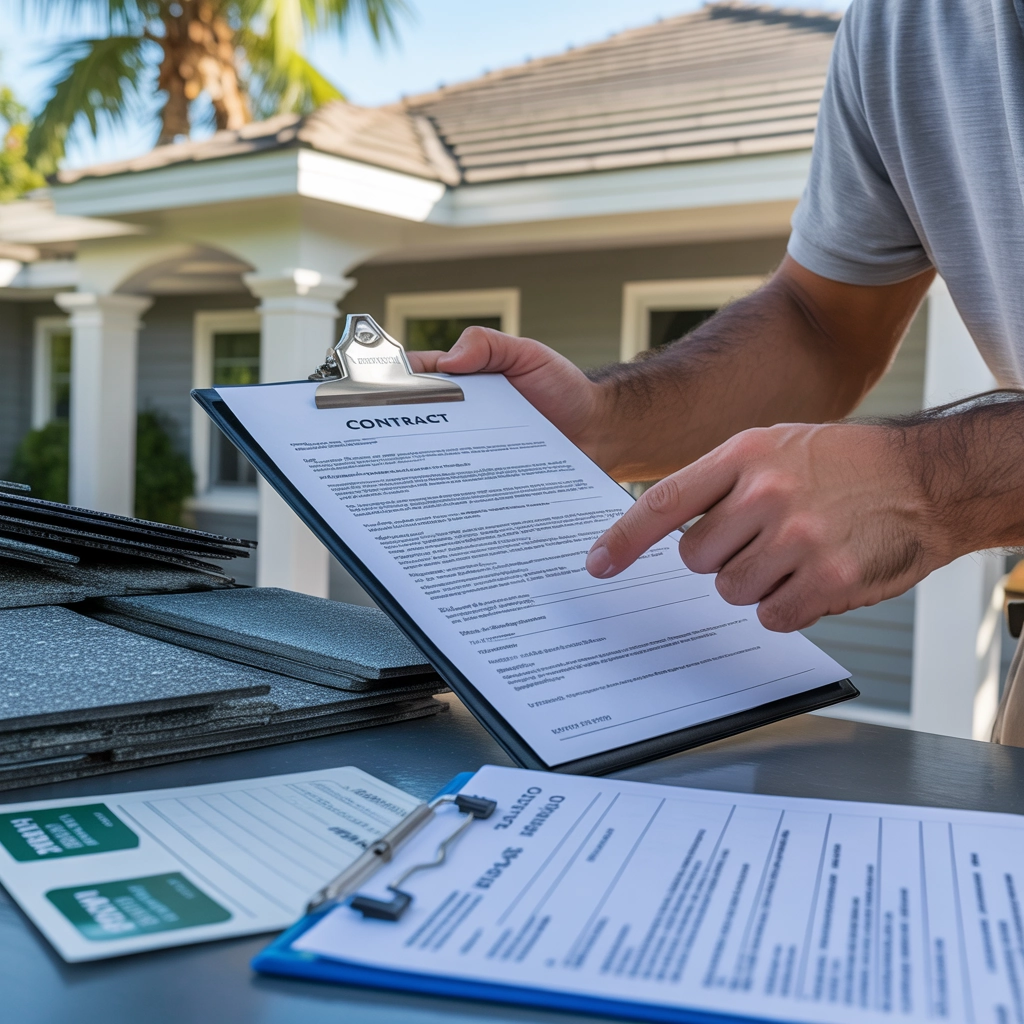
Consumer Protections Under House Bill 715
House Bill 715 introduces several significant consumer protection measures specifically designed to protect homeowners from fraudulent or predatory roofing practices.
Cancellation Rights:
- Standard Cancellation: Homeowners can cancel contracts within 10 days of signing or the project start date (whichever comes first) without penalty.
- Emergency-Related Cancellation: Residents in state-declared emergency areas can cancel roofing contracts within 180 days of the emergency declaration.
- Required Notifications: Contractors must clearly disclose these cancellation rights in all contracts.
Additional Protections:
- Anti-Solicitation Measures: Stricter regulations on door-to-door roofing sales
- Insurance Claim Handling: New limits on how contractors can interact with insurance companies
- Assignment of Benefits (AOB) Restrictions: Continued tightening of AOB practices to prevent abuse
Expanded Contractor Scope:
House Bill 715 also allows licensed roofing contractors to evaluate and enhance roof-to-wall connections in structures with wood decking. This provision enables roofers to perform more comprehensive storm protection work, provided it meets building code requirements or certified engineering standards.
State Senator Maria Alvarez, who sponsored the bill, noted, “These protections give homeowners more time to make informed decisions, especially during the chaotic aftermath of a storm when they’re most vulnerable to high-pressure sales tactics.”
Contractor Licensing and Requirements
Florida has always had strict contractor licensing requirements, but the 2025 laws take these a step further.
Key Changes for Contractors:
- Enhanced Background Checks: More thorough vetting of contractor applicants
- Continuing Education: Increased requirements for ongoing education about building codes and best practices
- Local Knowledge Testing: Additional testing on regional building requirements and climate considerations
- Digital Documentation: New requirements for maintaining digital records of all projects
Why This Matters for Homeowners:
Always verify that your roofing contractor holds a valid Florida license. The state’s Department of Business and Professional Regulation offers an online verification system.
Working with an unlicensed contractor not only risks poor workmanship but can also:
- Void your home insurance policy
- Create liability issues if workers are injured
- Result in permits being denied
- Leave you with no recourse if problems arise
At TCI Roofing and Solar, we maintain all required licensing and stay current with continuing education requirements to ensure we’re always in compliance with Florida’s latest regulations.
Material Requirements and Building Code Updates
The 2025 regulations also include updates to material requirements, reflecting Florida’s ongoing efforts to improve resilience against severe weather.
Notable Updates:
- Wind Resistance: Higher wind resistance requirements for roofing materials, especially in coastal areas
- Solar Reflectivity: New standards for solar reflectivity to reduce heat absorption and energy costs
- Sustainability: Incentives for using environmentally friendly roofing materials
- Installation Methods: Updated requirements for installation techniques to improve durability
Popular Compliant Options:
- Impact-Resistant Shingles: Designed to withstand hail and wind-blown debris
- Solar-Reflective Tiles: Reflect sunlight to keep homes cooler
- Metal Roofing Systems: Offering excellent durability and wind resistance
- Integrated Solar Roofing: Combining energy production with protective roofing
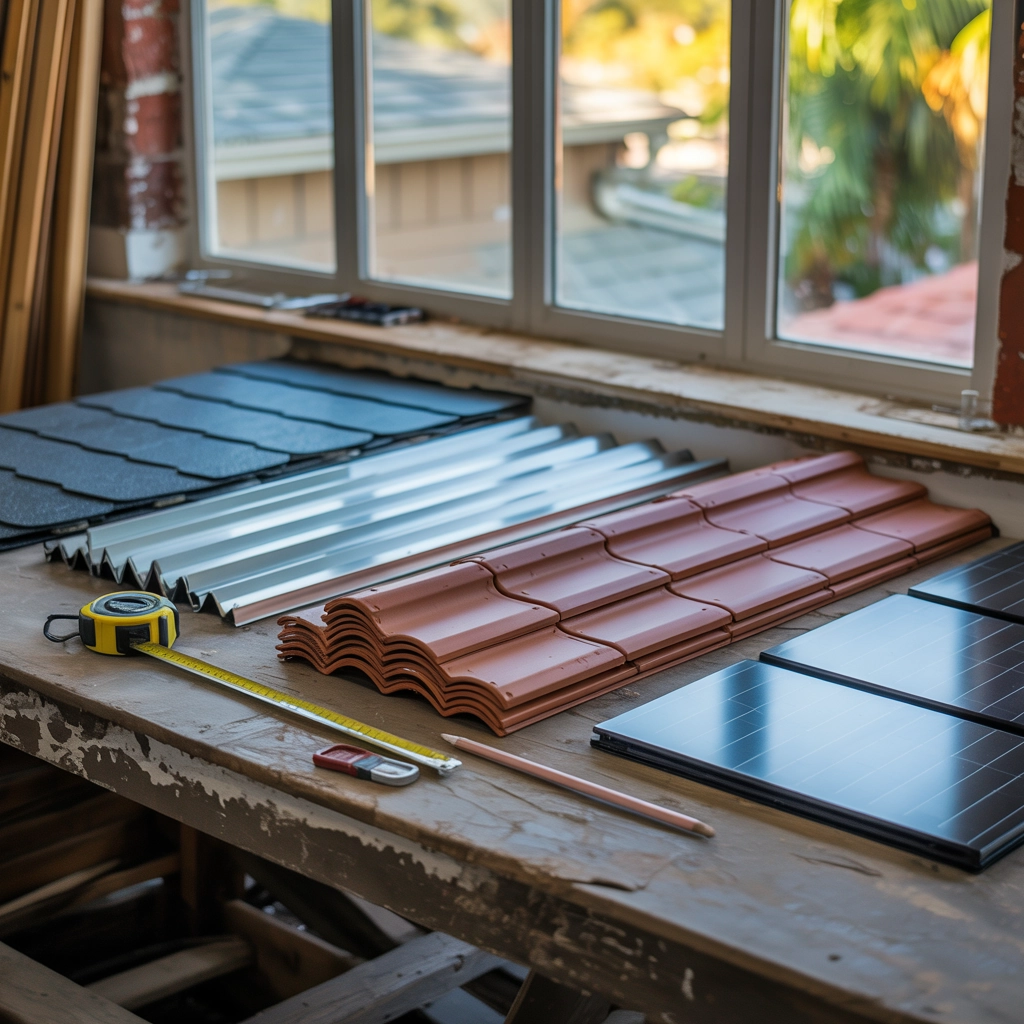
Preparing Your Home for Compliance
With all these changes, how can Florida homeowners ensure they’re prepared? Here’s a practical checklist:
Immediate Steps:
- Review Your Insurance Policy: Understand exactly what roof coverage you have and any age-related limitations
- Schedule a Professional Inspection: Document your roof’s current condition with a certified inspection
- Create a Maintenance Plan: Establish a regular maintenance schedule to extend your roof’s lifespan
- Gather Documentation: Collect and organize all existing roof documentation, including previous work orders and warranty information
- Budget for Future Needs: Based on your roof’s age and condition, begin financial planning for eventual replacement
When Hiring a Contractor:
- Verify Licensing: Confirm the contractor holds valid Florida licensing
- Check References: Request and contact references from previous customers
- Review Contracts Carefully: Ensure all required elements are included and clearly stated
- Understand Cancellation Rights: Know your options before signing anything
- Maintain Documentation: Keep copies of all paperwork in both digital and physical formats
How TCI Roofing and Solar Can Help
At TCI Roofing and Solar, we’ve stayed ahead of these regulatory changes to ensure our clients are always protected. Our approach includes:
- Comprehensive Inspections: Detailed assessments that meet insurance documentation requirements
- Clear, Compliant Contracts: All our contracts exceed the documentation standards required by Florida law
- Maintenance Programs: Preventative maintenance plans to help extend roof life and maintain insurance coverage
- Material Expertise: Access to the latest code-compliant, high-performance roofing materials
- Full Licensing and Insurance: Complete transparency with all our credentials and insurance coverage
- Documentation Assistance: Help organizing and maintaining the records you need for insurance purposes
Our team specializes in shingle roofing systems and can help you understand how these new regulations specifically affect your property.
The Integration of Roofing and Solar
One interesting development in the 2025 regulations is the increased focus on integrating solar technology with roofing systems. As experts in both roofing and solar installation, TCI is uniquely positioned to help homeowners navigate these opportunities.
The new regulations include incentives for integrated solar roofing solutions that:
- Enhance roof durability
- Increase energy efficiency
- Provide backup power during outages
- Qualify for additional tax benefits
For homeowners in New Port Richey, Pasco County, and Holiday, Florida, these integrated solutions can offer significant advantages under the new regulatory framework.
Conclusion: Staying Ahead of the Changes
Florida’s 2025 roofing laws represent a significant shift in how the state approaches roofing regulation. While these changes create new responsibilities for homeowners, they ultimately aim to create a more transparent, high-quality roofing industry that better serves Florida residents.
The key takeaways for homeowners:
- Regular maintenance and documentation are now critical for insurance purposes
- Clear, detailed contracts are required for all roofing work
- New consumer protections give you more time to make informed decisions
- Working with licensed, knowledgeable contractors is more important than ever
- Integrated solutions like solar roofing offer new opportunities under the regulations
By understanding these changes and working with qualified professionals like our team at TCI Roofing and Solar, you can ensure your home remains protected, compliant, and ready for whatever Florida’s weather throws your way.
Have questions about how these new laws affect your specific situation? Contact our team for a personalized consultation and learn how we can help you navigate these changes with confidence.
